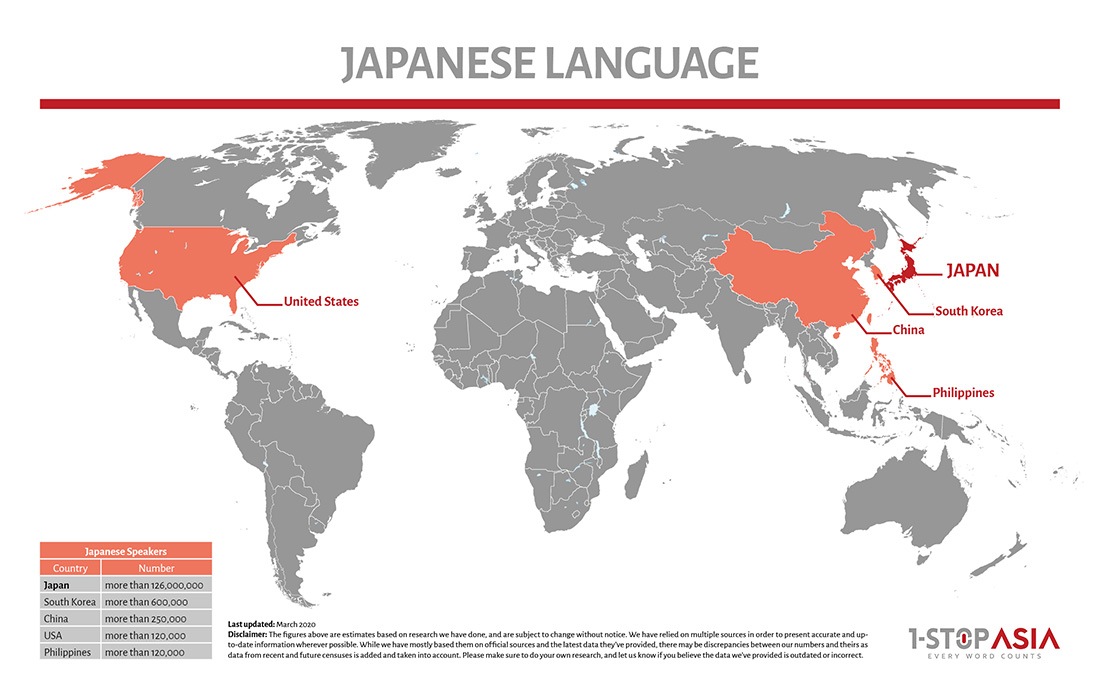Japanese Language
Reach 126M Japanese Speakers with Expert Translation Services
Japanese is a complex language with regional and cultural nuances. At 1StopAsia we specialize in Japanese translation and have a dedicated in-house team that understands how the language evolves across time and location. We make sure the right linguists work on the right projects so we can deliver content that is accurate, culturally relevant, and ready for the Japanese market.
Japanese requires careful attention to tone, style, and culture as well as the unique demands of the language.
Whether you’re translating documents, a website, or business communications, Japanese content needs more than just a direct translation. At 1StopAsia we bring the expertise of deeply understanding the language and its context to every project and guarantee you smooth communication in the chosen language.
You feel it is high time you focus on what matters most - your clients? We can assist.
Why Professional Japanese Translation Requires Expertise?
The Written Language
Professional Japanese translation involves more than fluency – it requires a deep understanding of cultural and linguistic systems that are very different from Western languages. Here are a few of the core challenges:
Honorifics (Keigo)
Japanese uses three distinct levels of politeness: teinei-go (polite), sonkei-go (respectful), and kenjō-go (humble). Each is used based on the context, status of the speaker, and relationship with the audience. Choosing the wrong form can unintentionally convey the wrong tone and cause confusion.
Kanji Complexity
Kanji characters carry meaning through visual structure, not just sound. A single character can have multiple readings depending on context. Understanding how these characters function and how they combine to form a meaning is essential for accurate translations.
Grammar Differences
Unlike English’s Subject-Verb-Object structure, Japanese typically follows a Subject-Object-Verb order and direct translation without adjusting for this structural difference can be confusing
Name Order and Formatting
Japanese name writing also differs. They write the family name first, followed by the given name. When localizing content, especially in systems that handle user input, messaging, or personalization, name formatting must be adapted appropriately to avoid errors or awkward phrasing.
The Spoken Language
Japanese is rich in homophones (words that sound the same but have entirely different meanings depending on the kanji and context). For example, “hashi” can mean:
- 橋: bridge (stress on the i)
- 箸: chopsticks (stress on the a)
- 端: edge or corner (same pronunciation as bridge)
In spoken Japanese, intonation can help in understanding the meaning but in written form only the correct kanji reveals the intended word.
This adds an extra layer of complexity for translators. Apart from word-to-word translation, they must interpret the meaning based on tone, context, and character usage. The same goes for idioms, proverbs, and nuanced expressions – getting them right in English without losing the original intent takes both linguistic and cultural expertise.
Get exclusive insights into the world of translation, localization, and the language industry.
How We Can Support You
Native Translators with Local Expertise
At 1-StopAsia Japanese translation is one of our core specialties, refined over years of hands-on experience. Whether your project requires human translation by industry experts or a machine approach with a human touch, we tailor our process to your goals. Our team works closely with you to ensure the final result is accurate and culturally appropriate.
25 years of experience
Through our 25 years in the industry, we’ve built a team of professionals who truly understand the challenges of translation workflows. They quickly assess clients’ needs and provide professional translation services to match them. Always ready to assist with your inquiries, they also save you time while delivering you accurate translations.

